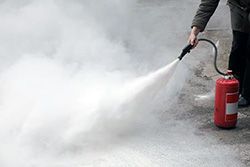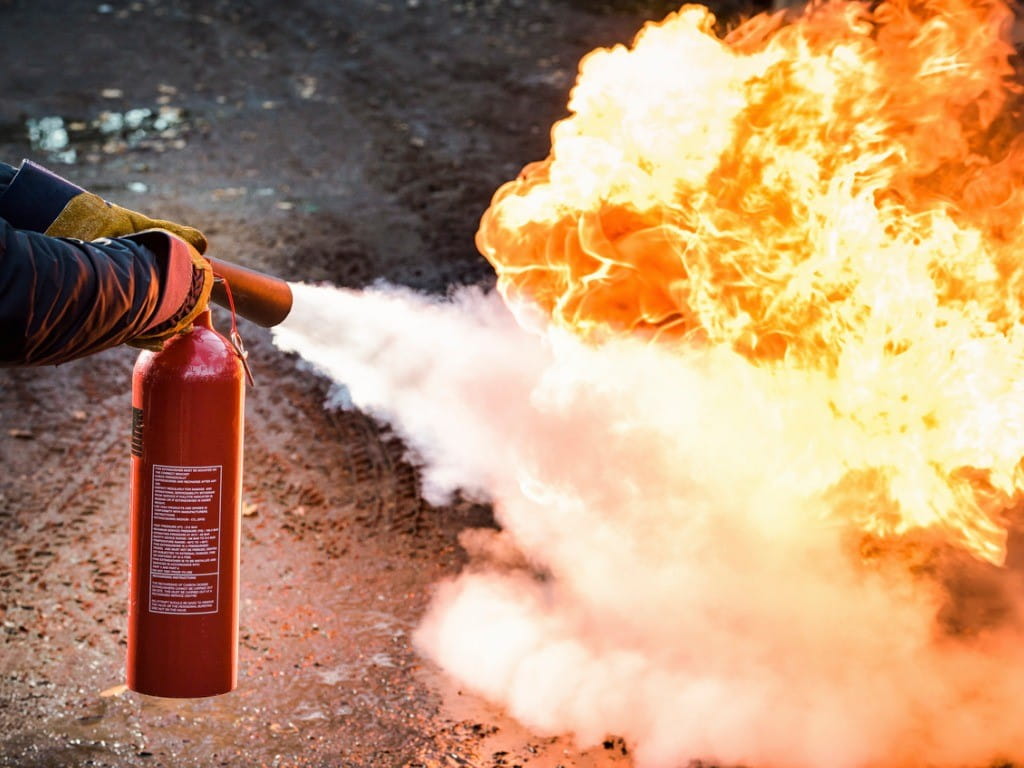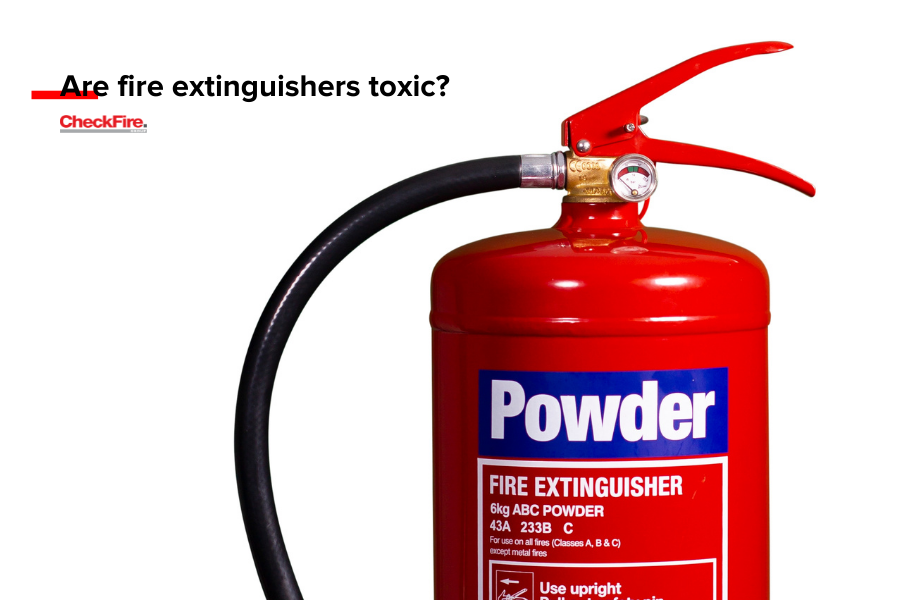Powder fire extinguishers are not toxic but can cause irritation if inhaled or ingested. Proper handling minimizes health risks.
Powder fire extinguishers are essential tools for combating various types of fires, including Class A, B, and C fires. They contain a dry chemical powder that effectively smothers flames and prevents re-ignition. While these extinguishers are not toxic, the powder can cause respiratory and skin irritation if mishandled.
It’s crucial to use them in well-ventilated areas and avoid direct contact with the powder. Proper training and adherence to safety guidelines ensure effective and safe usage. Always consult the extinguisher’s manual for specific instructions and precautions to maximize safety and effectiveness.
Introduction To Powder Fire Extinguishers
Powder fire extinguishers are common safety devices. They help fight fires quickly and efficiently. Understanding how they work can improve safety in homes and workplaces.
What Are They?
Powder fire extinguishers are filled with a special powder. This powder can put out different types of fires. The powder is usually made from chemicals like monoammonium phosphate or sodium bicarbonate.
These extinguishers come in different sizes. They can be small for home use or large for industrial settings. The powder works by smothering the fire. It cuts off the oxygen supply, stopping the fire.
Common Uses
Powder fire extinguishers are versatile. They can be used on several types of fires. They are effective on Class A, B, and C fires.
- Class A fires: Fires involving solid materials like wood, paper, and textiles.
- Class B fires: Fires involving flammable liquids like gasoline, oils, and paints.
- Class C fires: Fires involving gases like propane, butane, and methane.
These extinguishers are commonly found in various places. You can see them in homes, offices, and factories. They are also used in vehicles and on boats.
They are especially useful in areas with multiple fire risks. This makes them a popular choice for many safety kits.
| Setting | Common Fire Risks |
|---|---|
| Homes | Kitchen fires, electrical fires |
| Offices | Paper fires, electrical fires |
| Factories | Chemical fires, machinery fires |
| Vehicles | Engine fires, fuel fires |
| Boats | Fuel fires, electrical fires |

Composition Of Powder In Fire Extinguishers
Understanding the composition of powder in fire extinguishers helps determine their safety. These fire-fighting tools contain various chemical ingredients. Each component has a specific role in extinguishing fires effectively.
Chemical Ingredients
The powder in fire extinguishers typically contains monoammonium phosphate or sodium bicarbonate. These chemicals are commonly used due to their effectiveness.
Monoammonium phosphate is a fine, yellow powder. It can smother flames by separating the fuel and oxygen. Sodium bicarbonate, or baking soda, is another common ingredient. It releases carbon dioxide when heated, which helps extinguish the fire.
| Ingredient | Function |
|---|---|
| Monoammonium Phosphate | Smothers flames by separating fuel and oxygen |
| Sodium Bicarbonate | Releases carbon dioxide to extinguish fire |
How The Powder Works
The powder works by interrupting the chemical reaction in the fire. It removes the heat and oxygen from the fire triangle. This effectively puts out the flames.
When you activate the extinguisher, the powder is discharged. It creates a barrier between the fuel and the air. This action stops the combustion process almost immediately.
Another benefit of using powder extinguishers is their versatility. They can be used on various types of fires, including electrical, flammable liquids, and ordinary combustibles.
- Effective on Class A, B, and C fires
- Quickly stops the combustion process
- Creates a barrier between fuel and air
Potential Health Risks
Powder fire extinguishers are effective at putting out fires. But they can pose health risks. Knowing these risks is important for safety.
Inhalation Dangers
Inhaling the powder from fire extinguishers can cause issues. The powder can irritate the lungs and throat. This may lead to coughing or difficulty breathing. People with asthma can have more severe reactions. Always wear a mask when using a powder extinguisher.
Skin And Eye Contact
Contact with skin and eyes can also be harmful. The powder can cause skin irritation or rashes. If it gets into the eyes, it can cause redness and pain. Always wash your hands after using a fire extinguisher. Use water to rinse any affected areas immediately.
Summary Table Of Health Risks
| Health Risk | Symptoms | Prevention |
|---|---|---|
| Inhalation | Coughing, breathing issues | Wear a mask |
| Skin Contact | Irritation, rash | Wash hands |
| Eye Contact | Redness, pain | Rinse with water |
Safety is important when using powder fire extinguishers. Knowing the potential health risks can help you stay safe.
Environmental Impact
Powder fire extinguishers are effective tools for fighting fires. But they have significant environmental impacts. Understanding these impacts is crucial.
Effect On Wildlife
Wildlife can be adversely affected by powder fire extinguishers. The chemicals can harm animals’ health. They may ingest or inhale the substances, leading to poisoning. Small creatures like insects and amphibians are especially at risk.
Birds can suffer from respiratory issues. Mammals may experience skin and eye irritation. In severe cases, exposure can be fatal.
Soil And Water Contamination
Soil contamination is a major concern with powder fire extinguishers. The chemicals seep into the ground, affecting plant growth. This can disrupt local ecosystems.
| Contaminant | Effect on Soil |
|---|---|
| Ammonium Phosphate | Inhibits plant growth |
| Sodium Bicarbonate | Alters soil pH |
Water contamination is another issue. Runoff can carry chemicals to water bodies. This harms aquatic life. Fish and other aquatic creatures may die from chemical exposure.
Contaminated water can affect human health too. Drinking water sources may become unsafe. The chemicals can disrupt local water treatment processes.
Safety Measures And Precautions
Powder fire extinguishers are essential safety tools. They help in controlling fires. But are they toxic? Understanding the safety measures and precautions is crucial.
Proper Usage Guidelines
Powder fire extinguishers are effective against different types of fires. Here are some usage guidelines:
- Read the instructions before use.
- Point the nozzle at the base of the fire.
- Squeeze the handle to release the powder.
- Sweep the nozzle from side to side.
The powder can be messy. Wear protective gear like gloves and masks. This helps in avoiding inhalation.
Disposal Of Used Extinguishers
Disposing of used powder fire extinguishers needs care. Follow these steps:
- Check if the extinguisher is completely empty.
- Contact local waste disposal services.
- Inform them about the extinguisher type.
- Follow their instructions for safe disposal.
Do not throw extinguishers in regular trash. Improper disposal can be harmful.
| Step | Description |
|---|---|
| 1 | Check if empty |
| 2 | Contact disposal services |
| 3 | Inform about extinguisher type |
| 4 | Follow instructions |
Safety measures ensure that powder fire extinguishers are used correctly. Proper disposal prevents environmental harm.

Toxicity Levels Compared To Other Extinguisher Types
Understanding the toxicity levels of fire extinguishers is vital for safety. Different types of extinguishers have varying levels of toxicity. This section compares powder fire extinguishers to CO2 and foam extinguishers.
Co2 Vs. Powder
CO2 extinguishers release carbon dioxide gas. This gas displaces oxygen to put out fires. CO2 is not toxic but can cause breathing issues in confined spaces. It’s safe for use on electrical fires.
Powder extinguishers use a chemical powder to smother fires. The powder can cause respiratory irritation if inhaled. It is more toxic compared to CO2 but very effective on various fire types.
| Extinguisher Type | Toxicity Level | Primary Use |
|---|---|---|
| CO2 | Low | Electrical fires |
| Powder | Moderate | Multi-purpose |
Foam Extinguishers
Foam extinguishers use water-based foam to suppress fires. The foam is less toxic than powder. It can cause minor skin irritation but is generally safe.
Foam extinguishers are ideal for Class A and B fires. They are not suitable for electrical fires. The lower toxicity makes them a safer option for most environments.
- Foam is suitable for liquid fires.
- Foam causes minimal respiratory issues.
- Foam is less harmful to skin.
In summary, while powder extinguishers are effective, they have higher toxicity levels compared to CO2 and foam extinguishers. Choosing the right extinguisher depends on the specific fire risk and environment.
Regulatory Standards And Certifications
Understanding the regulatory standards and certifications for powder fire extinguishers is crucial. This ensures their safety and effectiveness. Various regulations govern their usage, ensuring they meet specific safety criteria. Below, we delve into the key regulatory standards and certifications.
Government Regulations
Government regulations set strict guidelines for fire extinguishers. These rules ensure they are safe and effective. Different countries have specific regulations. In the United States, the National Fire Protection Association (NFPA) sets the standards. In Europe, the European Standard EN3 is followed.
These standards cover various aspects:
- Material composition
- Performance efficiency
- Labeling requirements
Regulatory bodies frequently update these standards. This ensures fire extinguishers are always safe to use.
Safety Certifications
Safety certifications are essential for powder fire extinguishers. They provide assurance of quality and safety. Certified extinguishers undergo rigorous testing. This is done by recognized organizations.
Some important certifications include:
| Certification | Issuing Body |
|---|---|
| UL (Underwriters Laboratories) | United States |
| BSI (British Standards Institution) | United Kingdom |
| CE Marking | European Union |
These certifications ensure the extinguisher meets safety standards. They also indicate the extinguisher has passed performance tests.
Using certified fire extinguishers provides peace of mind. You can trust they will perform effectively in emergencies.

Frequently Asked Questions
Are Powder Fire Extinguishers Safe To Use?
Yes, powder fire extinguishers are safe for most environments but can cause respiratory irritation if inhaled.
Can Powder Fire Extinguishers Cause Health Problems?
Powder fire extinguishers can cause minor respiratory issues if inhaled. Proper ventilation and protective gear are recommended.
Is Cleanup From Powder Fire Extinguishers Difficult?
Yes, cleanup can be challenging. The powder residue can be messy and may require thorough cleaning to remove completely.
Conclusion
Powder fire extinguishers are generally safe when used properly. They can pose risks if inhaled or ingested. Always follow safety guidelines during use. For peace of mind, consider consulting experts to ensure the best choice for your needs. Remember, safety is paramount when dealing with fire emergencies.

